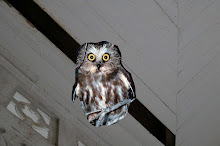We talked about 11 types of sheep. We didn't get a chance to spin all the breeds in class (I think this could easily have been a six week course - or six months - instead of just six hours), but I will be playing with them all at home.

We started by spinning three breeds - a long wool, a fine wool and a down. The type of wool helps you determine how to spin it and what to use it for. A coarse wool makes a great, durable rug, but it terrible for baby blankets.
Here is a fine wool (Cormo) on the left and a long wool (Wensleydale) on the right. See how different? Isn't it awesome!?!?

I only spun 5 breeds, but I'm quite smitten with Cormo. I haven't tried the Wensleydale yet. It has the most adorable little locks and I haven't found the nerve to muck them up yet. See how cute:

How a wool is prepared and spun makes a big difference too. You can line all the individual fibers up in one direction and spin the wool tight, or you can make the fibers go all which-ways. This makes lots of room for air to get in the nooks and crannies of the fiber, which results in a fluffier yarn.
These are both cormo, but you can see that one is fluffy and one is tighter and smoother. The top yarn was spun woolen - the wool is carded so the fibers go nutty and produce a fluffy yarn. I'm not very good at this yet, so my newness accounts for some of the bumps, but that's ok in a woolen yarn. The next step is to wash the spun yarn in hot water and then beat the crud out of the skein. It makes the yarn "bloom" and fluff up even more. I haven't done it yet, but spinners say it is very gratifying.

The bottom yarn was combed. This lines up all the long fibers, and helps discard the short ones, and creates a lovely strip of smooth wool. I am now addicted to hand combing.
Here are some other samples I spun:

After class, I bought stuff! My first raw fleece!! These are both fine wool from mutt sheep. The dark is Maine Island/Cormo/Border Leicester. I forget what the white is.

I also bought 4 oz balls of roving. These are a mix of different sheep and alpacas. I got them to experiment with blending colors. I think there will be enough for a vest when I'm done.

The brown one is 50% camel! (Yes, Mom, I had to get brown.)

There are interesting economics in wool and you can really see how value is added as the wool becomes processed. For the same price as 1.25 pounds of colored roving, I got over 3.75 pounds of unprocessed fleece (the garbage bag might look small, but trust me, it's heavy!):

Had I bought yarn for the same price, I would have gotten about 0.4 pounds of sock-weight yarn from an independent dyer. I like that the economics of wool seem so honest. So many other consumer goods (doritos, ipads, oil) have wonky subsidies and outsourced externalities that make the actual cost of the good far higher than the price we pay. Buying fiber directly from farmers or mills or independent dyers feels a little cleaner for my soul.
So now, I'm off to play!


No comments:
Post a Comment